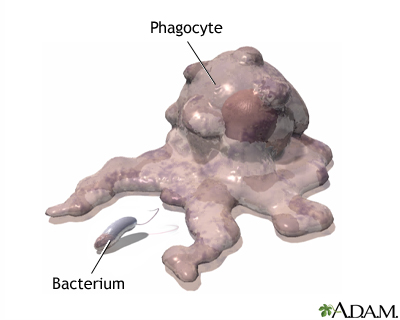Immune Response
Immune system structures

The immune system protects the body from potentially harmful substances. The inflammatory response (inflammation) is part of innate immunity. It occurs when tissues are injured by bacteria, trauma, toxins, heat or any other cause.
Phagocytosis

The chemicals also attract white blood cells that "eat" microorganisms and dead or damaged cells. The process where these white blood cells surround, engulf, and destroy foreign substances is called phagocytosis, and the cells are collectively referred to as phagocytes. Phagocytes eventually die. Pus is formed from a collection of dead tissue, dead bacteria, and live and dead phagocytes.
The immune response is how your body recognizes and defends itself against bacteria, viruses, and substances that appear foreign and harmful to the body.
The immune system protects the body from potentially harmful substances by recognizing and responding to so-called antigens. Antigens are large molecules (usually proteins) on the surface of cells, viruses, fungi, or bacteria. Non-living substances such as toxins, chemicals, drugs, and foreign particles (such as a splinter) can be antigens. Substances that contain these antigens are recognized and destroyed by the immune system. Even your own body cells have proteins that are antigens. These include a group of antigens called HLA antigens. Your immune system learns to see these antigens as normal and does not usually react against them.
No comments:
Post a Comment